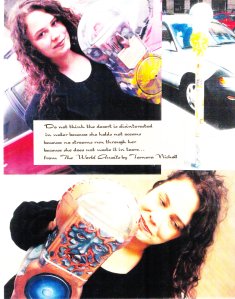
Rhyme and Meter Project in front of the Albuquerque public library in 1999. This project launched during poetry month.
Several years ago, while living in Albuquerque New Mexico, I conceived of a pun-inspired public art project. The project, entitled Rhyme and Meter, brought poetry and art together in the public realm. Excerpts of poems were affixed to downtown parking meters which were then painted by local artists as an illustration of the poem. In essence the parking meter became the page in a public book of poetry.
When I first started sharing the idea, it was hard for people to imagine. After all, they had never seen a parking meter covered with art and a poem. People liked the idea of transforming a disliked but-necessary part of the downtown parking infrastructure into a vehicle for beauty, but some people assumed that I would be executing the project as a clandestine effort conducted under the cover of night and not as a project fully blessed by the city’s mayor and head of parking.
They were wrong. But they were only wrong because I inadvertently stumbled across the power of the word “pilot” program, a term whose power I would later hear Andres Duany, the founder of the Congress of New Urbanism, espouse to a room full of urban visionaries.
The organization that made the Rhyme and Meter project possible and to whom I owe this happy discovery was the Downtown Action Team. They embraced the concept of adorning the downtown parking meters with poetry and art as part of a larger downtown revitalization effort. They not only allowed me to pursue the project under the umbrella of their organization, but also provided invaluable guidance. It was one of their members that suggested I scale back my initial vision of a 20 parking meter project to a four parking meter project and call it a “pilot.”
It would be much easier to get permission to paint four parking meters, they explained, than 20. The project would seem less threatening and thus less risky for city officials to support. If the meters turned out terrible, then they could easily be repainted. Since there was a strong potential for positive publicity and no cost for the city in undertaking the “pilot program,” permission was relatively easy to secure. Much to the surprise of many of my friends, the project was approved with little effort by the head of parking and the mayor’s office, despite a lack of strong buy-in.
While that stronger buy-in would be necessary for the larger project, which was to involve several blocks of painted poetic parking meters, only weak buy in was needed for the pilot project. The pilot would serve as a proof of the concept, inspiring others to get on board for the larger project. Four parking meters also required fewer resources in terms of paint, plaques, and the number of artists required. Since fewer resources were needed, this also meant I needed to convince fewer sponsors about the merit of the idea. We were also able to use to pilot as a way of experimenting with materials. We tested sign paint on one meter and auto paint on another. We tried a metal plaque for the poetry on one of the first four meters and painted the poem directly on another.
So in summary, pilots:
- Make it easier to secure buy in
- Typically require fewer resources
- Allow for course correction
- Help stakeholders visualize new ideas
While the famous architect and planner Daniel Burhan is often quoted as having said “Make no little plans; they have no magic to stir men’s blood,” there is also a problem when we develop creative, innovative projects that are never realized. Sometimes men are not willing to have their blood stirred, and at those times a pilot may be just the mechanism needed to make the vision immediate and clear.
I understand that not all projects will lend themselves to being piloted/ But since my discovery of the pilot, I have employed it time and again.
In the end, we launched our pilot with a media event that featured an unveiling and “meter reading.” Tim Durant, the ombudsman for the mayor at the time slipped down to the project site, took one look at all the members of the media present, the positive reception by the attendees, and promptly phoned the mayor to come on over. In an on-camera interview, the mayor said “Yes, we are planning on doing all of downtown.” I nearly fainted. My initial vision had only been for 20 meters. Thus sometimes a pilot can make your project bigger than you had initially planned. Over the next two years we rolled out two more projects bringing the total number of meters we completed to 25. No, I did not get to all the meters in downtown before I needed to move back to Texas for family reasons. But the power of a pilot made progress a possibility.